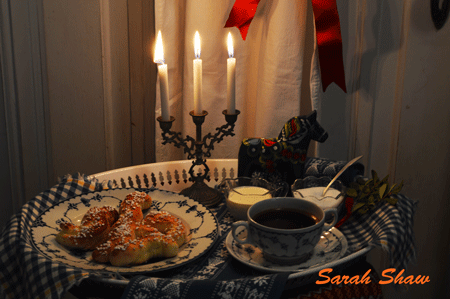
Lucia Day is celebrated each year on December 13 throughout Scandinavia. It is a fascinating mix of facts and myths surrounding a young woman from Syracuse, Italy whose life and death in the 3rd century lead eventually to her sainthood. The traditions inspired by Saint Lucia have been especially embraced by Swedes and there are a number of related activities that many families could add into their holiday celebrations. I am Swedish on my mother’s side and have always enjoyed the romantic imagery of Lucia Day festivities. I think you will enjoy it too!

If we start at the beginning, we will find ourselves first in Italy. As specific records of Saint Lucia’s life were not kept until centuries after her death, details are based off of a series of legends. A blend of these will give us the idea of who Saint Lucia was. Lucia was born into a wealthy noble family in the late 3rd century. During that time, the ruling Romans were still very suspicious of people of the Christian faith. Lucia is said to have made a secret vow to devote her life to serving the poor and God. The strikingly beautiful Lucia spent much of her time giving food to the poor and needy. Some of the people were hiding in caves to escape persecution. Carrying her heavy load required both of her hands. To light her way, she stuck candles in a wreath she wore on her head.
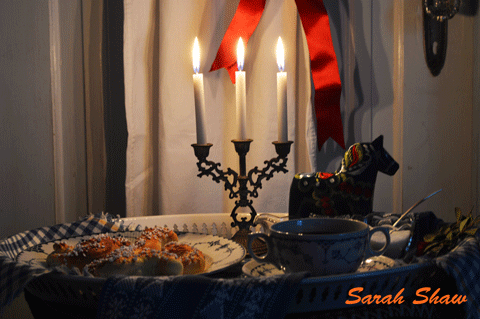
Some of the stories have her widowed mother stricken with a serious illness that was only cured after Lucia offered a life of service to God. Lucia’s significant dowry was then distributed to the poor around the same time she refused to marry her betrothed. Irritated, her would-be husband is said to have testified that she was a witch to get back at her. A single woman, with no dowry, at that time was doomed to a life of prostitution. When she refused to go to the brothel, the Roman guards tried to forcibly remove her. It is said that they were unable to budge Lucia. She seemed to be anchored in place. They were then ordered to build a fire around her. None of the wood would burn. Frustrated by this obvious witchcraft, one of the guards pulled out his sword and thrust it through her throat thus killing her. Soon after, miracles began to occur.

No one knows for sure how the legends of Lucia made its way to Sweden. It is possible that traveling monks, artists and craftsman brought it with them as they worked their way to northern Europe. Germany also celebrates its own Lucia traditions. At times Vikings visiting Britain may have picked up stories during peaceful interactions , later sharing them at home on their return. It is interesting how devoted Protestant and Lutheran countries that actively rejected all things Catholic would embrace an Italian saint. One link is provided by a popular story set in a time of great famine in Scandinavia. During the coldest, darkest day of winter a ship is said to have appeared with a woman dressed all in white sighted on deck. She passed out food to all the starving people and everyone believed her to be Saint Lucia working one of her miracles again.
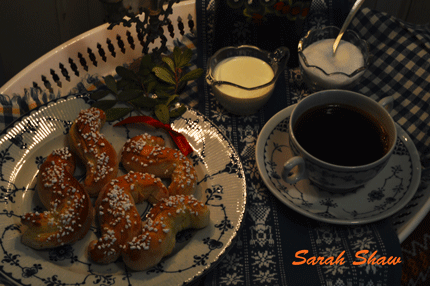
Sweden used the Julian calendar until the beginning of the 14th century . There is a discrepancy of 8 days between the Julian calendar and the Gregorian calendar we use today. The winter solstice, or the shortest day and longest night of the year, under the Julian calender fell the day before December 13 which is Lucia Day. And as far north as Sweden is, they really do experience a much shorter period of light than we do. You can see how it would be appealing to picture an image of a beautiful woman, bathed in light and bearing a bounty of food visiting you in your time of greatest need. And why not look forward to that event every year? That is the essence of how Lucia Day is celebrated today.
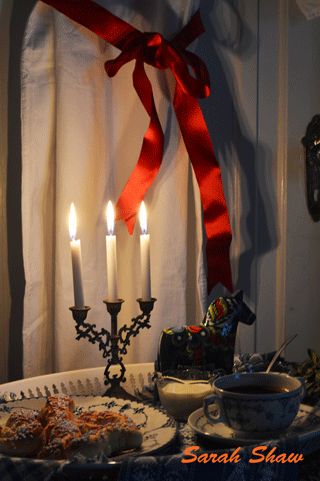
Before dawn, the girls of the household dress in long white gowns and bring trays of food and coffee to their parents while the way is lit by candles. The eldest daughter is designated Lucia and she wears a crown of lingonberry leaves with candles placed around its circumference. She also wears a red satin sash symbolizing the wealth of the dowry Lucia was born to but then chose to give away. Her attendants also dress in white gowns. They carry their candles and have a crown and sash of tinsel, instead. Those who are practical and safety minded, have opted now for battery operated candles instead of the real thing.
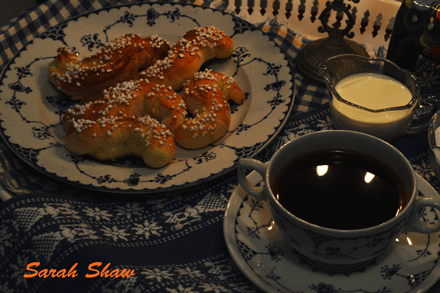
The food offered on Lucia Day always includes Lucia buns. Traditionally these are made with saffron which adds a golden tint to the dough as well as a delicious scent and flavor. Lucia buns are formed into special shapes. One will always see a design that is a stylized “S” with a swirl of dough at each end. The center of each swirl bears a raisin. Many other shapes are also popular and it may be a matter of preference in each family. One book I have suggests a number of options diagramming how to build each one with the dough. They include Joseph’s Beard, Wagon Wheels, Star of Bethlehem, Crown of the Virgin, a Goat, and the Shepherds’ Star. Another popular offering is a ginger cookie called pepparkakor. I can’t imagine a holiday season without a tin of pepparkakor in my house.
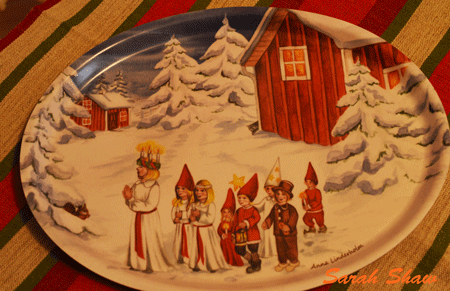
Although daughters get a lot of the glory on Lucia Day, the boys have found a place in the celebrations, too. Many boys join the procession dressed as Star Boys. They may also wear a white gown but they carry a wand with a star at the tip as well as a white cone shaped hat decorated with stars. Other boys may dress as tomte, a Swedish elf or gnome, who carry lanterns. Another popular role for boys is to dress as gingerbread men. The boys get to be a little more playful and mischievous in their positions while the girls take the role of distributing food and carrying the candles more seriously.
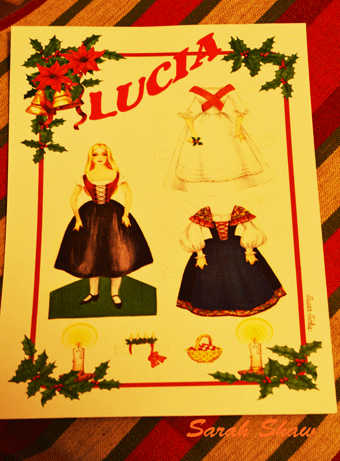
Lucia Day processions extend far beyond the family home. Lucia Day is celebrated in school and may be the final day of classes before breaking for Christmas vacation. One girl may be chosen to be Lucia and the other girls play the role of her attendants. I read that some girls may assemble before dawn and visit the homes of favorite teachers to serve treats and coffee there. Each town and city in Sweden is also likely to have it’s own Lucia. In fact in Stockholm, the Nobel Prize for Literature is awarded a few days before Lucia Day. It is a tradition for the winner each year to crown the new Lucia. There are many opportunities to become a Lucia as each church, business and many clubs also select a Lucia of their own.
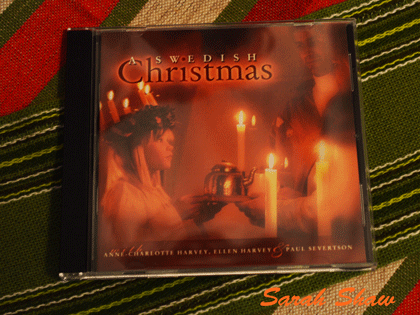
When selecting a Lucia for a city or group, it is important to not turn the process into a beauty contest. A girl may begin to serve as Lucia in her home as early as 6 years old or so and continue into her teens. One quality that is definitely helpful for your Lucia to possess is a decent singing voice. There are a number of traditional songs the group sings during their procession and having a pleasant voice definitely will add to the enjoyment. Lucia is remembered both for her sacrifice (in refusing to marry and giving away her dowry) as well as for her service to the poor. Lucia Day is the perfect occasion to remind girls and boys of the importance of helping others less fortunate. I could see organizing a food drive for a local food bank or shelter as a wonderful extension of the holiday.

Saint Lucia and Lucia Day imagery is very popular in Sweden. It is easy to find many contemporary items in Scandinavian import stores or through Swedish vintage and antique sellers on eBay or Etsy. Images of girls playing Lucia are regularly found on serving items like trays, plates and napkins. You can also find ornaments for your Christmas tree and other figurines for displays in the form of Saint Lucia or the Star Boys. Although you have missed the opportunity to celebrate Lucia traditions on Lucia Day this year, the coming weeks are some of the best of the year to purchase used or vintage items. The weeks and months leading up to the holiday are when everyone is collecting their Lucia Day supplies. I would start searching sites in January when shops will be looking to sell related items rather than store them for another year. If you are not finding what you are looking for, be sure to ask. Many dealers will be willing to hunt down what you are seeking.
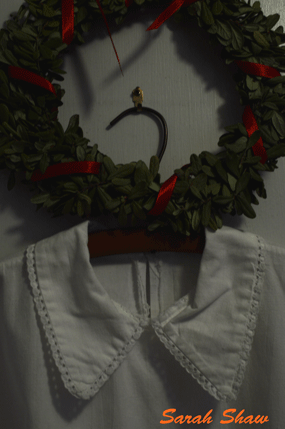
I am tremendously indebted to my favorite in-country Swedish source for all things beautiful, Caroline Henkelius of Maranghouse. She has a shop on both Etsy and eBay, although they are both closed at the moment for a holiday break. Caroline tracked down the Lucia gown I have featured in my photos. She also made the crown for me from her lingonberry bushes. Caroline is a photographer and stylist for many magazines and websites in Sweden. After hunting down treasures at estate sales for her images, she lists these wonderful items for her customers to buy. I think she has the prettiest product images of any shop I’ve seen. And I have loved everything I have ever bought from Maranghouse. One of her specialties is vintage and antique rag rugs which always make a space special. I will be featuring Caroline and Maranghouse in a future installment of WanderShop. I also suggest you follow her on Facebook at her fanpage, Maranghuset, so you can see all her gorgeous images and get inspired like I do!
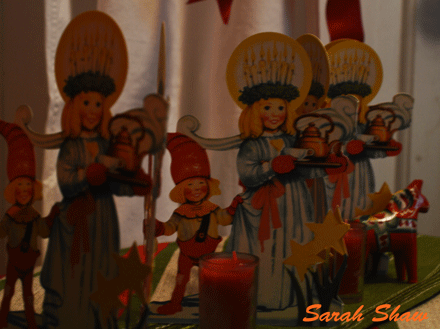
In the United States, I always turn to Ingebretsens for Swedish goods. If you live in Minneapolis, I’m sure you already know them. This year I purchased the Lucia Child of Light book by Florence Ekstrand there. More on that wonderful book in a moment. They also supplied me with the pearl sugar I used to dress the Lucia buns I made. Those not used to this decorative Swedish sugar often mistake it for salt. I use it all the time in my Swedish cookie baking and recommend you try it to create a new look for one of your old favorites. Ingebretsens was also my source for the Lucia julrader I have pictured. Julrader are folded decorative paper that expands out like an accordion. They are available in many different vintage images and are wonderful for decorating windows. For the holiday season, I always have julrader across each window and like to station votive candles at each inward bend. I’ll show you more images in a future post on Swedish Christmas decorating. The CD of “A Swedish Christmas” as well as the the Lucia Paperdoll sheet were also from Ingebretsens. Here is a link for all their Lucia related items. They offer all things Scandinavian. I have shopped with them for years and highly recommend them to you.
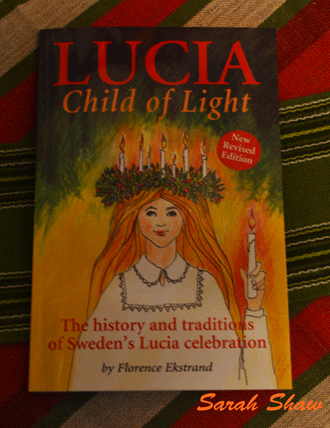
I have a large collection of Swedish books and cookbooks that all have sections which teach about Swedish holiday traditions. Most devote a page or two to Lucia Day. I was thrilled to discover Lucia Child of Light this year. Coming in at 62 pages, it is the definitive source on all things Lucia – at least as it relates to Sweden. It is written in a way that is definitely interesting for adults. I could also see a pre-teen who wants to learn more about her Swedish roots also enjoying the book. It would her give all the background she would need to understand the significance of the role she is about to play as Lucia. In addition to offering the history and back story to Lucia traditions, author Florence Ekstrand also offers several recipes for your Lucia tray as well as words (in English and Swedish) and music for traditional songs. Anyone wishing to learn more should seek out this book. I purchased it from Ingebretsens for just $9.95.
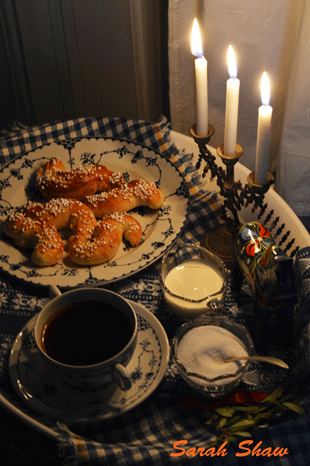
I’ve had a lot of fun pulling together everything for my Lucia Day this year. The nostalgic image of a swaying white dress, bathed in candlelight, enrobed in the scents of saffron buns and coffee, on a cold dark winter morning is really appealing to me. I hope you have learned a little more about this special tradition practiced with enthusiasm by our neighbors in northern Europe. I really like celebrating and modelling examples of service to others for the children in our communities. Making it a honor to serve is a tradition worth maintaining. What do you think?
Until we shop again,
Sarah
















